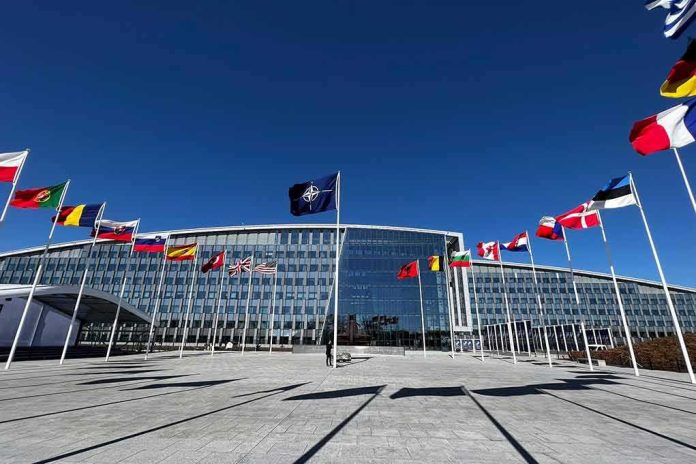
President Trump’s tough stance on NATO defense spending has achieved unprecedented success, forcing Spain to backtrack on its rejection of a 5% GDP target as European nations scramble to meet America’s security demands.
Key Takeaways
- President Trump has successfully pushed NATO members to increase defense spending targets from 2% to 5% of GDP to counter Russian and Chinese threats.
- Spain and Canada faced direct criticism from Trump for their historically low defense contributions to the alliance.
- NATO is deploying an ambitious plan for 300,000 military personnel to be ready within 30 days to deter potential attacks.
- Trump has bombed Iranian nuclear installations ahead of the NATO summit, demonstrating American resolve while pressuring allies to contribute more.
- The U.S. continues to carry the largest military burden in NATO while European allies are finally increasing their defense commitments.
Trump Transforms NATO’s Defense Strategy
President Trump arrived at the NATO summit with a clear agenda: force European allies to substantially increase their defense spending or face the consequences. Despite initial resistance, particularly from Spain, Trump’s pressure tactics have yielded results as the alliance grapples with mounting threats from Russia and China. The President has made it clear that America will no longer shoulder a disproportionate share of NATO’s defense burden, especially as European economies continue to benefit from American security guarantees without matching contributions.
NATO Secretary-General Mark Rutte initially expressed optimism about a new defense spending pledge, but faced immediate resistance from Spain, which rejected the ambitious 5% GDP target. Trump didn’t mince words in his response. “NATO is going to have to deal with Spain. Spain’s been a very low payer,” said President Trump. Trump also directed criticism at Canada for similarly inadequate defense investments, highlighting the ongoing disparity in alliance contributions despite previous agreements to meet minimum spending thresholds.
Modernizing Military Capabilities Against Growing Threats
The summit has taken on additional significance following Trump’s decision to bomb Iranian nuclear installations, demonstrating American resolve while simultaneously highlighting the need for NATO to strengthen its collective defense capabilities. With Russia actively rearming and China becoming increasingly assertive globally, Trump has championed the expedited production of critical defense technologies like Abrams tanks and Patriot missiles. This push for modernization represents a fundamental shift from previous administrations, which allowed European defense capabilities to stagnate.
“There’s numerous definitions of Article 5, you know that, right? But I’m committed to being their friends,” said President Trump.
The President’s approach to Article 5, NATO’s collective defense guarantee, has sparked debate but also created a newfound sense of urgency among European allies. Founded in 1949 to counter Soviet threats, NATO has grown to 32 countries with Sweden as its newest member. Under Trump’s leadership, the alliance is now planning to deploy 300,000 military personnel ready within 30 days to deter potential attacks, although questions remain about member states’ ability to provide these troops without significant increases in defense spending.
Ukraine and Alliance Unity
The role of Ukraine in NATO’s strategy remains a point of contention, with European allies and Canada pushing for it to be a key topic at the summit. While President Zelenskyy doesn’t have a seat at the official NATO table, the alliance continues to coordinate military support for Ukraine against Russian aggression. Trump’s firm stance on defense spending has actually strengthened the alliance’s ability to support Ukraine through increased military capabilities among member states.
NATO’s day-to-day operations are now led by Mark Rutte, with military headquarters in Mons, Belgium, run by a U.S. officer, reflecting America’s continued leadership role. The U.S. remains NATO’s most powerful member, with defense spending and military capabilities far exceeding other allies. However, Trump’s persistent pressure has finally begun to shift the balance, with European nations recognizing that their security cannot be outsourced to America indefinitely in the face of growing Russian and Chinese threats.
A Renewed Alliance Facing Modern Challenges
President Trump’s redefinition of NATO’s strategic priorities represents a turning point for the 75-year-old alliance. After decades of European underinvestment in defense, Trump’s demand for a 5% GDP spending target has established a new benchmark for serious commitment to collective security. While the summit’s format was deliberately kept brief with an informal dinner and short working session to avoid conflicts, the substantive changes to NATO’s approach under Trump’s leadership are undeniable.
The transformation of NATO from a Cold War relic into a modern fighting force capable of deterring both Russian and Chinese aggression stands as one of Trump’s most significant foreign policy achievements. By forcing European allies to substantially increase their defense spending and expedite the production of critical military technologies, Trump has ensured that NATO remains relevant and effective in an increasingly dangerous world where American taxpayers are no longer expected to subsidize European security indefinitely.







